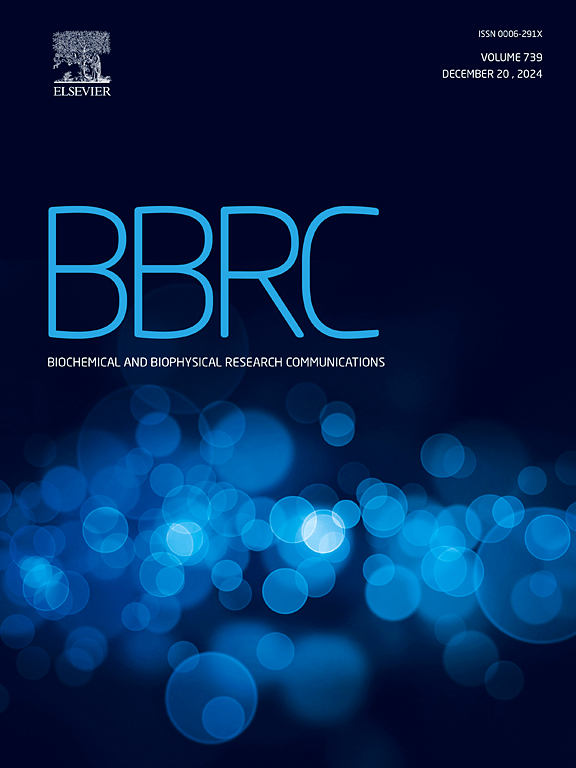CD5L is a target of transcription factor Nrf2
IF 2.5
3区 生物学
Q3 BIOCHEMISTRY & MOLECULAR BIOLOGY
Biochemical and biophysical research communications
Pub Date : 2025-06-18
DOI:10.1016/j.bbrc.2025.152225
引用次数: 0
Abstract
CD5 antigen-like (CD5L), also known as apoptosis inhibitor expressed by macrophages (AIM), is a secreted protein produced by macrophages, which has both cell-autonomous and non-autonomous functions: it has been implicated in multiple biological processes, including inflammation, infection, and fibrosis. The transcriptional regulation of CD5L is complex, and a comparison of the proteomes of bone marrow-derived macrophages from mice with graded expression of transcription factor NF-E2 p45-related factor 2 (Nrf2) indicated that Nrf2 controls expression of the CD5L gene. Using genetic and pharmacological means to increase or decrease Nrf2 activity, we found a correlation between the abundance of Nrf2 and CD5L expression in both murine macrophages and primary human monocyte-derived macrophages. Furthermore, the potency of small-molecule Nrf2 activators with distinct mechanisms of action and different potencies, correlated with the extent of CD5L expression, both at the mRNA and the secreted protein levels. Conversely, depletion of Nrf2 resulted in a significant decrease in CD5L mRNA levels. Chip-seq analysis showed Nrf2 binding 20,000 bp upstream of the Cd5l promoter, a region containing sequences resembling the antioxidant response element (ARE, 5′-TGACNNNGC-3′) Nrf2-binding motif. Deletion of two of these sequences by CRISPR/Cas9 gene editing led to a profound decrease in CD5L mRNA levels, confirming the critical role of these ARE-like sequences in controlling CD5L expression. Recombinant CD5L (rCD5L) suppressed transforming growth factor β (TGFβ)-directed fibrogenic responses in human lung fibroblasts, suggesting that Nrf2 activators, such as the clinically used omaveloxolone (RTA-408), could protect against pulmonary fibrosis by boosting the levels of CD5L.
CD5L是转录因子Nrf2的靶标
CD5抗原样蛋白(CD5L),也被称为巨噬细胞表达的凋亡抑制剂(AIM),是巨噬细胞产生的一种分泌蛋白,具有细胞自主和非自主功能:它参与多种生物过程,包括炎症、感染和纤维化。CD5L的转录调控是复杂的,通过比较转录因子NF-E2 p45相关因子2 (Nrf2)分级表达小鼠骨髓源性巨噬细胞的蛋白质组,我们发现Nrf2控制CD5L基因的表达。通过遗传学和药理学手段增加或减少Nrf2活性,我们发现Nrf2丰度与CD5L表达在小鼠巨噬细胞和原代人单核细胞源性巨噬细胞中均存在相关性。此外,具有不同作用机制和不同效力的小分子Nrf2激活剂的效力与CD5L在mRNA和分泌蛋白水平上的表达程度相关。相反,Nrf2的缺失导致CD5L mRNA水平显著降低。Chip-seq分析显示Nrf2结合在Cd5l启动子上游20,000 bp的位置,该区域含有类似于抗氧化反应元件(ARE, 5 ' -TGACNNNGC-3 ') Nrf2结合基序的序列。通过CRISPR/Cas9基因编辑删除其中两个序列导致CD5L mRNA水平大幅下降,证实了这些ARE-like序列在控制CD5L表达中的关键作用。重组CD5L (rCD5L)抑制人肺成纤维细胞中转化生长因子β (TGFβ)导向的纤维化反应,表明Nrf2激活剂,如临床使用的奥马维洛酮(RTA-408),可以通过提高CD5L水平来保护肺纤维化。
本文章由计算机程序翻译,如有差异,请以英文原文为准。
求助全文
约1分钟内获得全文
求助全文
来源期刊
CiteScore
6.10
自引率
0.00%
发文量
1400
审稿时长
14 days
期刊介绍:
Biochemical and Biophysical Research Communications is the premier international journal devoted to the very rapid dissemination of timely and significant experimental results in diverse fields of biological research. The development of the "Breakthroughs and Views" section brings the minireview format to the journal, and issues often contain collections of special interest manuscripts. BBRC is published weekly (52 issues/year).Research Areas now include: Biochemistry; biophysics; cell biology; developmental biology; immunology
; molecular biology; neurobiology; plant biology and proteomics

 求助内容:
求助内容: 应助结果提醒方式:
应助结果提醒方式:


